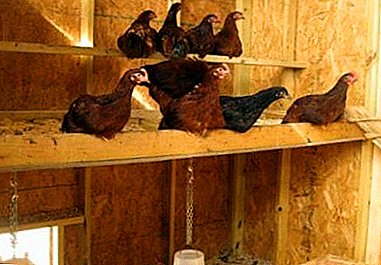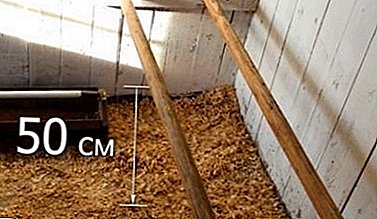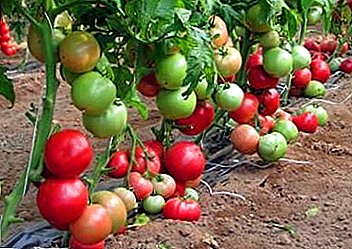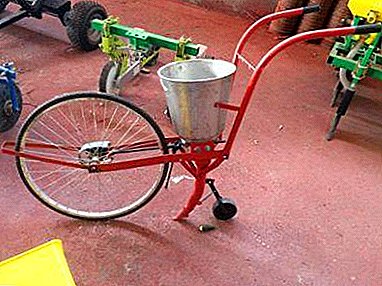
In order to get the best productivity from laying hens, it is necessary to create optimally comfortable and comfortable living conditions for them.
And in the construction of the perch, one must take into account the physiological characteristics of the birds, their size and the size of the chicken coop.
But, for a start, let's see what the roost is for?
What is the roost for?
It is necessary to ensure proper sleep and rest for the birds. The nest is the closest to the natural placement of chickens, this is how their wild relatives slept in ancient times.
In addition, you should not leave the birds to sleep on the floor and because of possible infection with viral or fungal diseases that are hidden in the dirty litter. We will talk about how to ensure perfect hygiene in the hen house in a separate article.
For convenient placement of chickens on perches, it is necessary to calculate what distance is needed for each of them. In winter, the birds are pressed against each other to warm up. And in the hot summer they need additional free space on the bar.
The main rule in the arrangement - all livestock should be placed easily and freely, the birds should not interfere with each other when moving, thus avoiding injury.
 Remember also that, in addition to perches, chickens will need nests, it is in them that birds will be carried.
Remember also that, in addition to perches, chickens will need nests, it is in them that birds will be carried.What kinds of them exist and how to make a nest for chickens with their own hands, we tell in detail in this article.
 Not all owners have the possibility of arranging a spacious and comfortable chicken coop.
Not all owners have the possibility of arranging a spacious and comfortable chicken coop.In this case, you can use the option with cells. How to equip cages for laying hens read in this material.
 And also it is worth taking care of the organization of free-range birds.
And also it is worth taking care of the organization of free-range birds.How to organize walking for chickensWhat distinguishes the aviary from the solarium and the free movement around the yard, you can read in detail here.
It is also worth responsibly to the choice of breeds of chickens for cellular or content in the chicken coop. So, for the first option fit: Lohman Brown, Leggorn, Hisex Brown and Kuchinsky anniversary. While the Brahms feel better with captive breeding, and Silk hens generally require special care.
If you decide to equip a comfortable chicken house, we told about how to do it yourself with your own hands here, then let's look at the question of what types of perches exist and how they differ between themselves.
Kinds
Before we talk about the types of perches, let's recall the natural structure of the chicken legs. The chicken leg has 4 fingers, three of which are looking forward, and one - back. Such a structure allows birds to cling tenaciously to the perch, and it is this that implies that the use of wide boards or bars will not suit us.
The diameter of the bar should not exceed 50 mm, and its edges must be carefully oshkurit so that the birds do not damage the legs.
Most often perches for chickens make such species.
Single deck
Such a perch is usually located along the wall at a distance of about 40 cm, with a height from the floor of 60 cm. The bar is fixed so that it cannot fall out or turn. A pallet under such a roost can not be done, because cleaning under it is easy to produce. Experienced poultry farmers do not recommend to equip it with a ladderas many do because chickens need physical activity to keep fit.



Multi-tiered
This type will help save space. Bars in this case are located in several tiers 0 one above the other. Do not forget to keep a distance of at least 50 cm between them. This will help to avoid the fact that higher sitting chickens will stain lower ones. remember, that among chickens there is a very clear hierarchy and the strongest individuals will always be at the very top.


Angular
Perfect for those who have a small population of chickens. It can be both single-tier and multi-tiered. We put the bars between two adjacent walls. The positive moments of this species are the simplicity of the performance and the possibility of placing it in a quiet corner of the hen house, where nothing will disturb the birds.
Of the minuses - not very convenient to clean under a multi-tiered structure. This problem can be solved by making the bars removable.


Portable
This type of perch is most often done in the form of a table with a tray. The pallet is used to collect the litter, and 1-3 rows of bars are arranged above it. Suitable for keeping chickens in a temporary room.. When assembling, keep in mind that it should easily pass through the door. This type has a second name - hygienic perch.


Lifting
This type of perch is different, that the bars are fixed with the help of loops. This allows you to maximize the cleaning process.

Lifting perch
Dimensions
When creating a perch, you need to remember two basic rules:
- it should not be placed too high or too low so that the birds are not injured and at the same time have a good physical exertion;
- the length should be calculated based on the number of birds, but too long a bar will sag under the weight of the population.
In the table you can see the optimal size of perches based on the size of the birds:
| Individual size | Small | Average | Large |
| Height from floor | 60-80 cm | 70-90 cm | 80-110 cm |
| Distance to wall | 25-35 cm | 35-45 cm | 45-55 cm |
| Vertical tier spacing | 30-35 cm | 40-45 cm | 45-50 cm |
| Horizontal distance between tiers | 35-40 cm | 45-50 cm | 50-55 cm |
| Distance from floor to pallet | 35-45 cm | 40-50 cm | 50-60 cm |
Where to place?
The question of where to place the perch is no less important than its size and appearance. As mentioned above, he must provide the hens with proper rest. Which means you need to arrange it at the far wall, it is desirable that there were no windows, away from the door, to avoid drafts and loud noises.
Perches should not be located above the feeders or drinkers.
In the photo below you can see the successful placement of perches in a well-planned hen house:


How to do it yourself?
If you decide to make a roost for chickens with your own hands, the following technology will help you. Moreover, it does not matter what type of roost you are going to make, the methods will be used the same.
- It is necessary to determine the size of the chicken coop, to clarify the location of doors and windows. It will be more convenient to use a drawing or diagram. For example, as you see in the photo below:


- Choose which option perches on the most suitable. We are convinced that it will not interfere when cleaning and collecting eggs, is not in the draft. Remember that between objects in the hen house you need to leave a distance of at least half a meter.
- We process bars. The most suitable for the manufacture of perches are hardwood. Pros - do not emit tar and do not bend under the weight, are easy to polish to a smooth state.
- Saw the bars to a predetermined size, then round them with a plane or a knife and grind to a smooth state. You can use a sander or dispense sandpaper.
- If you decide to use conifers, the bars can be processed using a blowtorch.
- For a permanent perch attached to a wall, you need to make supports from boards with grooves several millimeters larger than the diameter of the bars.
- The supports are attached to the wall with nails, bolts or screws, depending on the material from which the walls of the chicken coop are made. Use the level so that the perch is arranged strictly horizontally.
- By installing the bars in the grooves of the supports you need to check the tree for deflection. If the nest is very long, you can install an intermediate support.
- The device of multi-tiered perches involves the use of pallets for litter. To do this, you can lay the bars under the roost and cover them with sheets of plywood or tin. Tin sheets can be bent around the perimeter for easy cleaning. In size, the sheets should be 20 cm beyond the perch line and reach the wall from the back.
- If necessary, you can build a ladder or ladder with a tilt angle of 60 degrees and a distance of about 20 cm between the crossbars.
- Portable perch is a structure of four pillars connected along the perimeter of the board of the desired size. The connection is carried out in two rows of crossbars, with a removable litter pan at the bottom, and grooves for placing bars at the top.
The photo below again reminds what distances must be observed in the manufacture of roosts.

- Distance from the wall

- Perch height
Another interesting perch, easy to make and not requiring a lot of space, you can see in this video:
On how to make a removable litter pan we will describe below.
Manufacturing of a removable pallet
The size of the removable pallet is calculated based on the size of the perch. To maintain the necessary rigidity, it is better if the width does not exceed 60 cm. The length for a single-row roost is usually about 70 cm, and for multi-rows it is from 60 to 1 meter 20 centimeters.
The sides, 6-8 cm high, will prevent the dropping of litter and filler. One of the sides should be made with a slight slope, it will make cleaning more convenient.
Instructions for the manufacture of pallet:
- Draw a sketch or drawing with the exact size. Rectangle of the desired size + the required number of cm to bend the sides.
- On a sheet of tin make the markup with the help of a square and a marker.
- Cut out tin with jigsaw or grinder.
- It now remains to gently bend the sides. This will help us a wooden hammer and trimming boards.
- The edges must be trimmed to avoid injuries and cuts.



Ready-made pallets are placed under perches, filled with filler. We offer you detailed articles about hygiene in the hen house and its disinfection, about the proper organization of the litter in the hen house.
Build a roost with your own hands is not difficult. It is important to choose the best type of roost, based on a variety of factors: the size of chickens and their characteristics, free space in the hen house, etc.
Properly organized space will help preserve the health of livestock and increase their productivity.
















